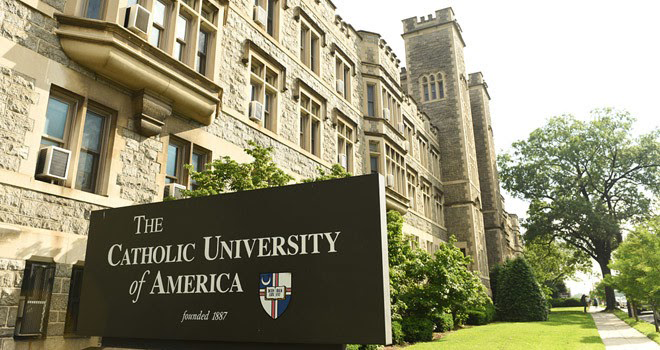Underpaid Catholic University Faculty and Staff Facing Possible Salary Cuts Amid COVID-19 Financial Crisis

Photo Courtesy of Crisis Magazine
By Jessica Fetrow
The Catholic University of America announced the possibility of a 5-10% salary cut on its faculty and staff in a faulty town hall meeting on June 9, in addition to the temporary suspension of contributions to 403(b) retirement plans amid the coronavirus financial crisis, which is to be decided on by a later date. This development of this plan comes nearly five months after university leadership announced the prioritization of increased pay for faculty and staff, following a study conducted by the consulting firm Mercer that revealed the underpayment of its faculty and staff at approximately 8% below the median market.
According to the President of the Faculty Assembly (FA) Dr. Binh Q. Tran, the announcement of this potential plan, made by university Vice President for Finance and Treasurer of the Board of Trustees Robert Specter, came as a surprise to faculty and staff, as university President John Garvey, Provost Aaron Dominguez, and Specter had expressed in several meetings and appearances before the Academic Senate throughout April their intention to advance with the plan for faculty and staff raises.
“I would like to recognize that last spring we committed to investing in faculty and staff salary increases over the next three years. The first installment of those raises was scheduled for this fiscal year,” said Garvey in an email to the Catholic University community on June 23. “Unfortunately, the pandemic has frustrated our plans. I am sorry this has happened. The increases were our top budgetary priority for this year, and we did everything we could to save them. Our commitment to this goal is unchanged, but advancing toward it this year is simply not possible given our current situation.
“These issues are front-and-center on the minds of our faculty,” Tran said. “Faculty are feeling betrayed, demoralized, and angry by these austerity measures. Many faculty and staff that I speak with feel that we are at a breaking point.”
The FA Executive Board initially commended the administration’s “intent to go forward with faculty raises,” which have now been postponed to the 2021 fiscal year at the earliest, in an email to faculty members on April 8.
“We are a bit embarrassed that we moved too quickly with our open gratitude,” Tran said. “In hindsight, perhaps we should have learned from the past.”
In a statement issued on May 19, Garvey stated that he had been meeting with Specter, the Leadership Group, the Academic Senate, deans, University Budget Committee, Administrative Council, Committee of Faculty Economic Welfare (CoFEW), and the Benefits Advisory Committee to explore options for “responding as a community to the continuing financial impact of the COVID-19 crisis.”
According to executive board chair of CoFEW Dr. Janice B Agazio, the committee met with Garvey at his request on May 14, when he shared the initial three-phase COVID-19 plan. According to Agazio and the May FA meeting minutes, CoFEW has been left in the dark for a majority of the planning and implementation of the COVID-19 financial plan.
“At that meeting, we made it clear that the meeting was informational only and we were not being asked at that time to approve or endorse the proposed plan,” Agazio said. “Additionally, we asked the President to allow us to weigh in before any of the plans or items were actually implemented. While the administration has held several town halls and informational sessions since that time, CoFEW has not been asked to meet or comment on the implementation of the plan nor the re-organizing of the priorities, as we understand that now there is a [four phase] plan.”
Agazio referred to this plan as a “triple hit” to faculty and staff, as the Mercer report already showed that faculty and staff are underpaid in addition to the new 403(b) discontinuation and salary cuts.
“We, in CoFEW, would like to see the administration consider more equitable plans with inclusion of faculty input to protect those more vulnerable to these measures moving forward,” Agazio said. “We recognize that we will all need to contribute to the university’s viability but that shared decision making and shared burden will be much more tolerable and equitable in the long run.”
In a survey conducted by the FA in May, there were feelings of “distrust, lack of transparency, and bait-and-switch amongst the faculty” over Dominguez and Specter’s intent to go forward with raises as expressed in the April faculty town hall and Academic Senate meeting, in addition to concerns about faculty reimbursements for personal online teaching resources.
“I personally love this University, and I want it to survive,” said an anonymous post on the FA Discussion Page. “And I know that the vast majority of faculty and staff feel the same. It breaks my heart that our upper administration refuses to listen to faculty, to consider our ideas. Something has to change.”
Several other anonymous posts expressed similar frustrations, stating that the primary issue is “that the administration is talking AT us; they are not talking WITH us.”
Last January, a study led by the human resources consulting firm Mercer was presented to the Academic Senate and found that university faculty and staff are paid at a rate of 8% less below the median market compared to similar universities, and 15-20% less than faculty and staff at Washington, D.C. universities such as Georgetown University, George Mason University, and Gallaudet University.
The university’s FA raised several concerns about the initial study in a statement from February, suggesting that outliers be removed from the survey as they bring down averages, cost-of-living adjustments be accounted for as the report does not account for cost-of-living in the D.C.-area, and that the university report salary by gender to avoid inequities. The suggestions by the FA regarding the Mercer report highlight that the report might not accurately reflect how Catholic University’s faculty and staff compare to similar schools.
In addition to the predetermined underpayment of Catholic University faculty and staff, The American Association of University Professors released the results of a 2019-2020 Faculty Compensation Survey which determined that on average, salaries for full-time faculty at U.S. colleges and universities increased by 2.8% in 2019-2020. Accounting for the 2.3% increase in consumer prices, the increase in real terms comes to 0.5%, and the core inflation rate (CPI) increased by 2.5%, further decreasing the value of salaries.
According to the “Statement from the Faculty Assembly On CUA’s Response to the COVID-19 Pandemic” released by the FA on May 29, the faculty and staff have received almost no raises since 2010, due to a pay freeze enacted during the Great Recession. This, combined with the lack of adjustment for cost-of-living discrepancies, “amounts to a full year of lost wages when compounded over the past ten years.” IRS 990 tax records show an 86% increase in payment of Catholic University’s top administrators from 2010-2016, while the increase in pay for all faculty and staff in that same time frame totals 12%.
The statement also calls for improving shared governance, increasing financial transparency, ensuring equitable budgeting, and protecting the most vulnerable.
“CUA is financially strong having doubled our net assets over the past decade,” Tran said. “Many amongst the faculty and staff believe we should tap our unrestricted funds to address this terrible crisis rather than on the backs of our faculty and staff.”
Under the division of ensuring equitable budgeting, the FA recommends that the university utilize existing resources, such as the approximately $130-150 million unrestricted university designated funds, before implementing salary cuts on faculty and staff.
While many faculty members feel that 20% pay cut by Garvey and 10% pay cuts for vice presidents is an “appropriate first step,” several have referred to this as a “token” cut and that cuts should be more severe for administrators.
“The token salary cuts taken by the upper administration come out of their excess and after years of increasing compensation, while faculty and staff cuts are of the same percentage, but come out of resources necessary each month to pay the bills and keep the lights on,” Tran said.
The administration’s alleged inability to work with its faculty and staff to create a collaborative plan to combat the current COVID-19 financial crisis has arguably created a significant point of tension between the two university divisions.
“There are other levers to pull rather than the constant cuts proposed,” Tran said. “At the end of the day, it is a matter of justice and practicing what we preach as a Catholic institution.”
Editor’s Note: In an earlier publication of this article, it was stated that a 5-10% salary cut would be implemented on all faculty and staff amid COVID-19 financial conflicts. On June 23, 2020, President Garvey released a clarifying statement saying that there is not a definitive plan to enact these salary cuts beginning this summer, and “if furloughs or salary adjustments were to be necessary” once the fall semester began, “they would be planned for and announced at that time.” The article has been revised accordingly. Please see our follow-up article for further clarification on this information.





